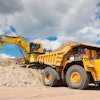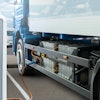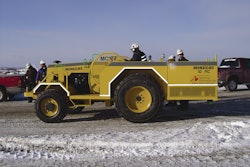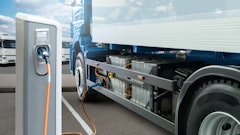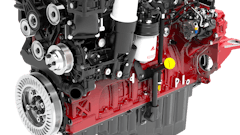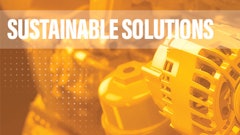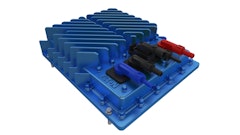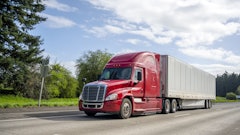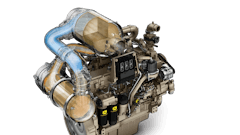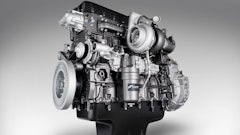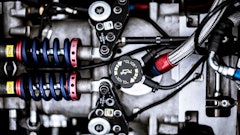Construction companies and equipment manufacturers beware! If California lives up to its tradition as the nation's bellwether of regulatory trends, you're about to feel a lot more pressure to reduce the emissions from equipment already in the field.
This spring, the California Air Resources Board (CARB) is set to consider new emission regulations for "in-use" off-highway equipment that are likely to require mandated retrofits or early retirement for some construction equipment. The regulations will be based on CARB's 1998 decision to label the particulate emissions in diesel exhaust as a toxic air contaminant, a move that allowed it to bypass federal restrictions on states' ability to regulate emissions on farm and construction equipment.
Since then, other states — and the federal government, as well — have labeled diesel exhaust, or some of its many components, as air contaminants, allowing them to pass regulations on equipment currently being used.
State regulators believe they have no choice but to go after existing equipment if they are to meet the stringent air quality standards imposed on them by the federal government.
They have to come up with formalized plans to meet federal air quality standards for ozone by this summer. In addition, they must develop similar plans to reduce particulate emissions by next spring.
Off-highway equipment is especially vulnerable because it accounts for an estimated 75% of all particulate emissions. With the introduction of clean-diesel engines and low-sulfur fuel, federal regulators have reached the threshold of achievable emission reductions from new equipment. The only place to achieve additional reductions is by targeting existing equipment.
A bleak assessment
In a new report (again from California), the Union of Concerned Scientists claims emissions from construction equipment is causing 1,100 premature deaths, 1,000 hospital admissions, 2,500 cases of acute asthma and tens of thousands of asthma attacks and other lung problems.
Digging up Trouble: The Health Risks of Construction Pollution in California, released in December of 2006, recognizes that the Tier 4 regulations that will be phased-in starting in 2011 will go a long way to reducing particulate emissions, but concludes that "the full benefits will not be realized until sometime after 2030, when the long-lasting equipment currently in use today has finally been retired."
The report notes that five types of construction equipment — excavators, tractors/loaders/backhoes, bulldozers, rubber-tired loaders and skid-steer loaders — account for 65% of particulate emissions and 60% of NOx emissions. It also notes that an excavator operating for one hour will emit as much particulates as an on-highway truck driven for 1,100 miles (see chart).
This bleak assessment is based on a somewhat skewed comparison. Off-highway emissions were based on an average of all existing equipment, regardless of age, using standard, high-sulfur fuel. Estimated emissions from on-highway trucks, on the other hand, were based on 2007 clean-diesel engines using ultra-low-sulfur fuel. Unfortunately for off-highway equipment manufacturers, this important distinction will likely be glossed over in any public debate.
While construction equipment may be a juicy regulatory target, achieving emission reductions could prove both challenging and costly. The Diesel Technology Forum, an organization that promotes diesel technology, says converting to ultra-low sulfur diesel could lower particulate emissions by 10% alone, without any equipment or engine changes. However, the ultra-low-sulfur fuel needed to achieve that won't be required for off-highway equipment until 2010, although it is available now.
How to achieve emission reductions?
Getting additional reductions will be trickier. Diesel particulate filters, which are considered one of the most effective retrofit components for reducing particulate emissions, are problematic for off-highway equipment, wherein operation is typically spikes of power separated by extended periods of idle time. In addition, off-highway equipment doesn't benefit from the cleansing effects of wind trucks can generate while traveling at 65 mph. In fact, off-highway equipment is typically operated in dusty or confined environments that make it difficult to keep filters clean.
Back pressure, generated by low-quality or poorly maintained aftermarket components, could lower fuel economy and damage engines. In addition, some components may not work without electronically controlled engines or low-sulfur fuels.
There are also size and visibility issues. Construction equipment tends to be compact. Engineers may find it difficult to add aftertreatment components in a way that will not hinder engine performance or the operator's visibility.
"The construction industry poses several unique challenges in retrofit decisions including extended idles and/or low-speed operation periods, vibration, high levels of dust, space limitations and operator visibility," the Diesel Technology Forum concluded in its 2006 report, Retrofitting America's Diesel Engines: A Guide to Cleaner Air Through Cleaner Diesel.
Finally, there is the issue of cost. More than 90% of the nation's construction companies are small businesses with fewer than 20 employees. They tend to be low-margin businesses and have most of their capital tied up in existing equipment. As a result, repowering or replacing equipment would have major financial implications.
According to Diesel Technology Forum's report, "retrofit technology offers few economic benefits and poses potential risks for owners due to downtime associated with installation and possible additional maintenance and training costs." It notes that repowering is a preferred option because "upgraded engines pose less performance risk and can improve equipment performance and longevity."
OFF-HIGHWAY EMISSIONS COMPARED TO ON-HIGHWAY TRUCKS | ||||
Equipment Type | Useful Life of Equipment | Share of Total Off-Highway PM Equipment | Truck Miles Equal Emissions From One Hour of Operation | |
PM | NOx | |||
| Excavator | 17 years | 17% | 1,100 miles | 200 miles |
| Tractors/Loaders/Backhoes | 18 years | 16% | 1,000 miles | 100 miles |
| Bulldozers | 29 years | 13% | 1,400 miles | 200 miles |
| Rubber-Tired Loaders | 21 years | 12% | 1,100 miles | 200 miles |
| Skid-Steer Loaders | 13 years | 7% | 500 miles | NA |
| Notes:
Source: Union of Concerned Scientists | ||||
Government steps in with funding
Fortunately, federal and state agencies are beginning to understand the financial implications and are stepping in to help.
The Diesel Emission Reduction Program, which was created through the Energy Policy Act of 2005, will be funded with up to $200 million a year through 2010 to provide grants and low-cost loans for retrofit projects. A nationwide program will administer 70% of the money, while the remaining 30% will be awarded to states to help fund their programs.
Federal funds are also available through the U.S. Highway Act of 2005, which gives contractors access to a pool of more than $1.5 billion a year that Congress sets aside for projects designed to reduce congestion or improve air quality. The legislation specifically includes retrofit funding as an eligible — and effective — strategy for reducing air pollution. This funding will likely be used by contractors who want to participate in federal or state highway projects that require contractors to use retrofitted equipment.
States have established funding programs, as well. Not surprisingly, the first was in California. The Carl Moyer program has provided $154 million in financial assistance to retrofit 7,000 diesel engines since its inception in 2000. The largest state-operated retrofit program is the Texas Emissions Reduction Plan, which has invested more than $336 million in grants, with the largest portion of the money going to off-highway projects.
Evaluating the Technology
Government agencies are also playing a major role in evaluating the feasibility of retrofit technologies for off-highway equipment. Two major construction projects — Boston's Big Dig and Connecticut's Q-Bridge Project — both have significant retrofit components to evaluate performance and emission reductions from retrofitted construction equipment.
In addition, California is preparing to launch its Off-Road DECS (diesel emission control strategy) Showcase Project, which is intended to generate operational data from retrofitted off-highway equipment, help develop relationships between off-highway equipment manufacturers and makers of aftertreatment components, and expand the number of state-approved emission-reduction devices.
"We hope to coordinate a diverse combination of devices and engines in an effort to verify as many devices as practicable for the broadest array of engines," says Erik White, chief of CARB's heavy-duty diesel in-use strategies branch.
Clearly, the age of retrofits has arrived.
Dave Jensen is a contributing editor based in Milwaukee, WI.

